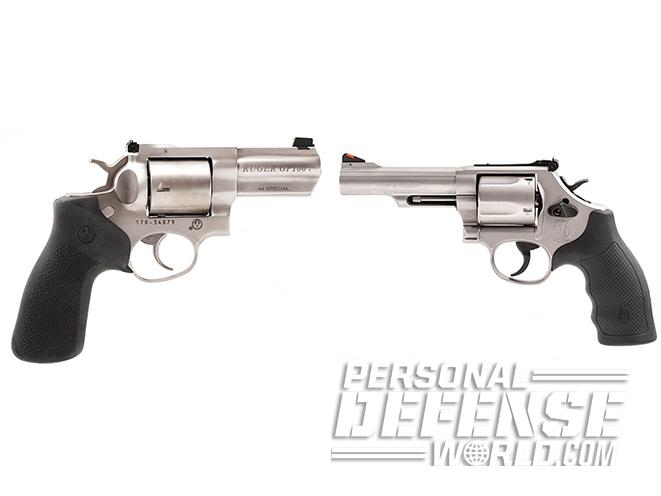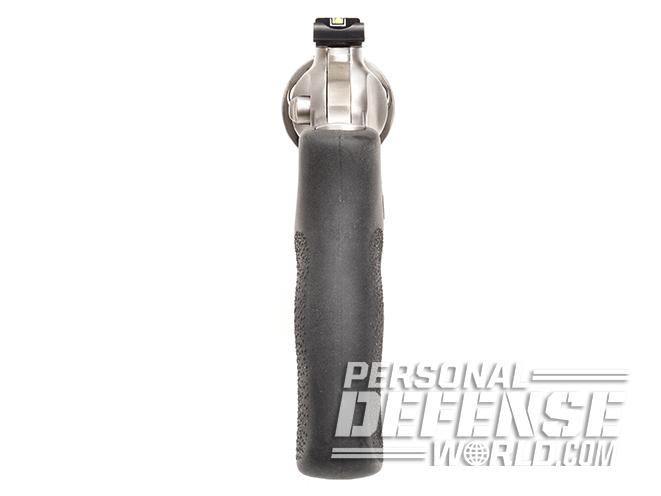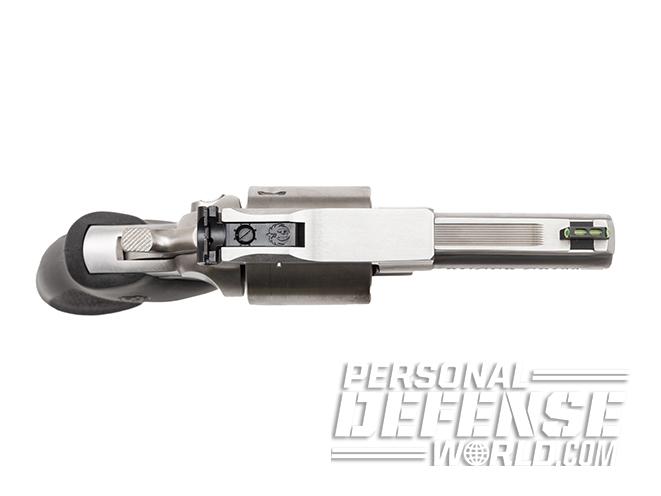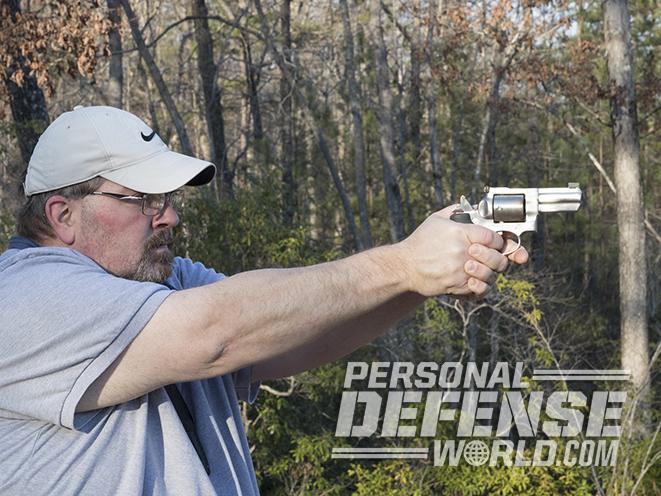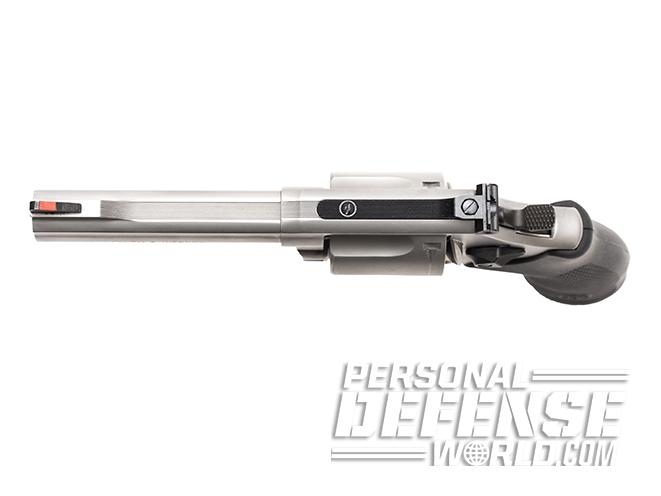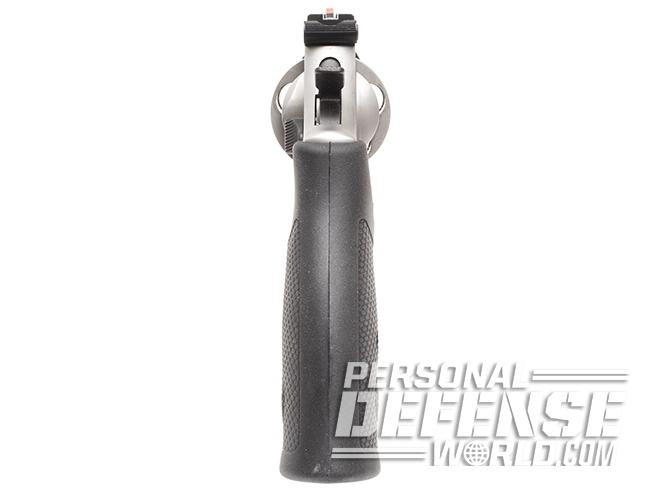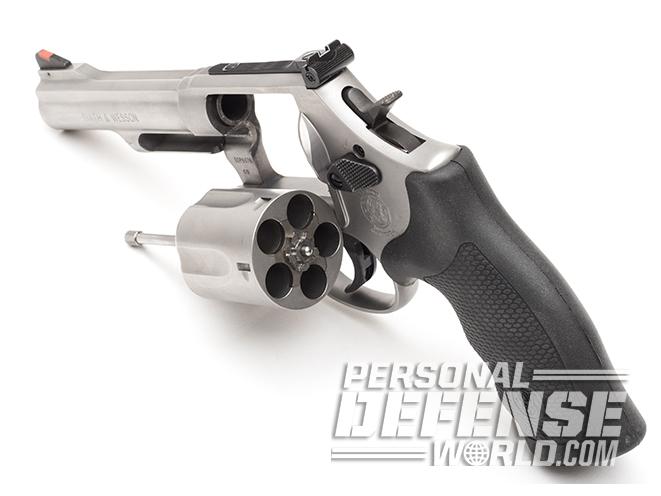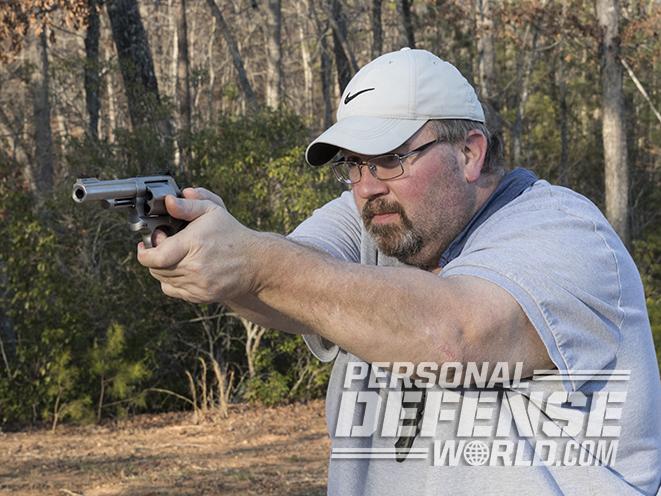Both Ruger and Smith & Wesson, with the help of modern steels and cutting-edge design methods, are keeping innovation alive in their respective revolver lines. Recently, both companies have introduced medium-framed revolvers in big-bore calibers for fans of handguns who are looking for the larger calibers, but in a more compact form. For this edition of the “Tale of the Tape,” we’ll take a side-by-side look at both the Ruger GP100 in .44 Special and the Smith & Wesson Model 69 in .44 Magnum. Though there are differences between the two, they both share a common trait that makes them very appealing as big-bore carry pieces. They are both built on the companies’ medium-sized frames, which usually max out at the .357 Magnum. To accommodate the larger cartridges, both companies reduced the standard capacity of six rounds to five. Dropping the sixth round allows for enough steel between the chambers in the cylinder to safely handle the larger cartridges.
Ruger GP100
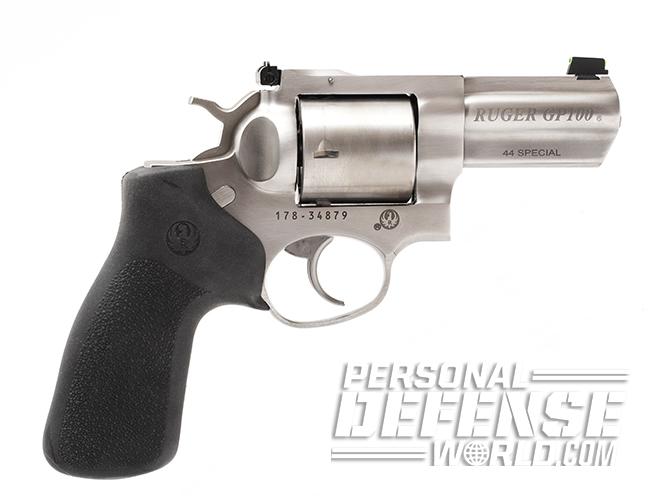
Ruger’s entry into this category was a bit of a surprise, but it’s a welcome one. Fashioned with a 3-inch barrel, the .44 Special GP100 is purpose-built to be a more concealable big-bore handgun. It sports a non-fluted cylinder, adding to both the appeal and the robust build quality for which Ruger revolvers are known.
Advertisement — Continue Reading Below
The GP100 comes with an extremely comfortable Hogue rubber grip that does a superb job of reducing felt recoil, even with some of the hottest .44 Special loads on the market. Normal loads barely register on the felt recoil scale. While this is a positive attribute for shooting, the large rubber grip does negate some of the revolver’s concealability, so it’s a bit of a trade-off.
- RELATED STORY: 4’s the Charm – On the Range with the Ruger Mark IV Hunter
Ruger’s offering also includes a green fiber-optic front sight for easier visibility along with an adjustable rear sight that is dressed with a white outline. The entire body is constructed of stainless steel with a satin finish, making the topstrap a little bright in sunlight, but the barrel has serrations on top to help ward off glare.
Despite being a medium-framed revolver, the GP100 isn’t what you’d call petite. It comes with a full underlug and tips the scales at 36 ounces. Its overall length is 8.5 inches, and it’s 6.25 inches tall at the front sight. While the chunky little offering is definitely concealable, the user will need a good holster and belt to make it work well for everday carry.
Advertisement — Continue Reading Below
S&W Model 69
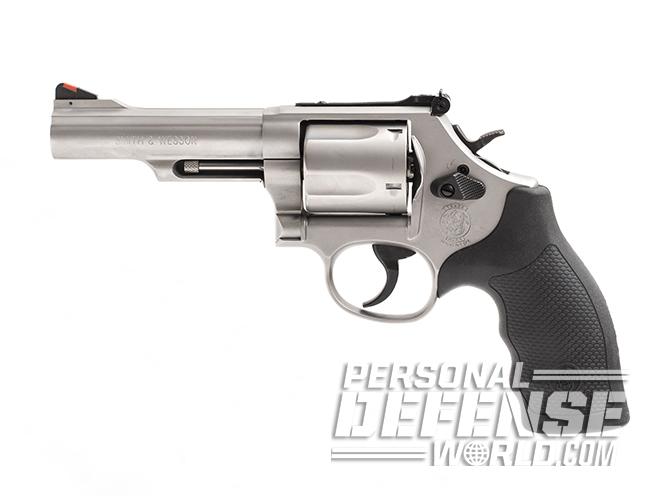
The Model 69 is actually chambered in .44 Magnum, thus allowing it to utilize .44 Special cartridges, but it still remains a medium-framed revolver. It, too, is made of stainless steel, but has a matte finish that is particularly good at chasing away reflections and glare.
The Model 69 also features a rear sight that is adjustable for windage and elevation and is trimmed with a white outline as well. The front sight is the red ramp commonly found on S&W revolvers.
Advertisement — Continue Reading Below
Though the grip on the Model 69 is also made of molded rubber, it is much more compact, similar to a boot-grip design. This rubber grip does make the revolver easier to conceal on that end of the gun, but this is offset by the longer 4.25-inch barrel.
The height of the Model 69 is about 5.88 inches at the front sight with an overall length of 9.6 inches, making it look sleeker and more compact, but its slim profile belies the heft of the revolver. It weighs in at 37.4 ounces unloaded. Even with the half underlug and the fluted cylinders to trade away weight, it’s still 1.4 ounces heavier than the Ruger GP100.
Range Shootout
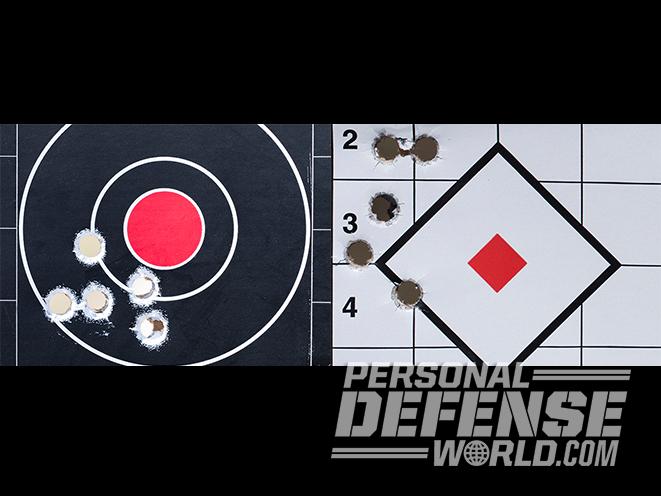
Both revolvers looked very promising, but the proof is in the shooting. So, I took both of them out to the range to see how they’d stack up. On hand was a supply of Sig Sauer’s 200-grain V-Crown .44 Special ammunition as well as Sig’s 240-grain .44 Magnum V-Crown rounds. I’ve been getting excellent results with Sig ammunition and wanted to try out these loads.
Advertisement — Continue Reading Below
I fired both revolvers from a standing rest at 15 yards because this distance is fairly all-inclusive for most real-life defensive shootings. I fired three 5-shot groups to get both an average group size and a best group size with each revolver.
With the 200-grain Sig .44 Special load, the Ruger turned in an average group size of 1.73 inches and a best group of just 1.38 inches. The Model 69 wasn’t too far behind with an average group size of 2.15 inches and a best group of 1.88 inches.
I would point out that this doesn’t necessarily reflect the inherent accuracy of these two revolvers, only what I was able to achieve with them. I found that I was able to get a more precise sight picture with the fiber-optic sight on the Ruger, especially in the shade. The red ramp front sight on the Model 69 became very dark when firing from shade, and it was harder to line up against dark targets. This seemed to bear out when I fired the Sig .44 Magnum rounds through the Model 69 as well. The best group size was 1.93 inches with an average group size of 2.27 inches. The red ramp works great in bright light but just gets muddy in lower light.
Advertisement — Continue Reading Below
However, the S&W Model 69 does have the distinct advantage of being able to fire .44 Magnum loads despite its medium size. As expected, shooting the magnum loads wasn’t fun from an L-Frame revolver, but it was doable. My hand didn’t get too beat up in the process, and I was able to make it through each full cylinder without needing to take a break—but not much longer than that.
The Sig .44 Special load had a velocity of 732 fps from the Ruger and 769 fps from the S&W. The slight velocity bump from the Model 69 is to be expected with the 1.25-inch longer barrel. Using the .44 Magnum ammo, the velocity jumped dramatically to 1222 fps.
The Upshot
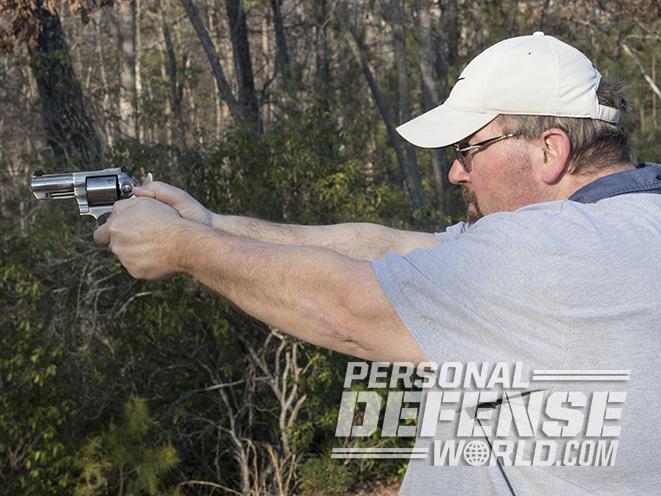
During the range tests, I was able to make a few observations regarding the two revolvers. First, there is a notable difference between the two grips, at least for me. The larger rubber grip on the GP100 was definitely more comfortable in terms of firing and handling.
Advertisement — Continue Reading Below
I felt the smaller grip on the Model 69 didn’t provide enough real estate to distribute the heavier weight of the revolver. After a few trigger pulls, the shorter reach to the trigger and the front-heavy weight of the longer barrel were causing my hands to cramp, even with the softer-shooting .44 Special loads. I already have a couple of L-Frame revolvers of my own, and they wear large rubber grips that make a huge difference when it comes to comfort.
On the other hand, the more compact grip on the Smith & Wesson Model 69 does make it more concealable, as the butt is usually the hardest part of a handgun to conceal. Also, for those who want a .44 Magnum that is light and comfortable enough to carry into the wild, the svelte profile and compact grip makes for an especially appealing trail gun. And since this isn’t necessarily a gun that would be shot all the time, the user is more than able to make it through enough defensive shots without worrying about the cramping issue.
The trigger pull weights are nearly the same on both revolvers, with the Ruger coming in at 10.25 pounds for the double-action pull and the S&W coming in slightly lower at 10 pounds. The GP100’s trigger had a longer throw, and in the middle of a slow rotation, I could feel the cylinder have to cross some sort of threshold, like it was going over a speed bump. It wasn’t at all unpleasant, and the GP100’s pull was very smooth. There was just a little resistance about halfway through. The Model 69 had a lighter pull, and it also felt like a shorter throw, but the trigger pull was smooth and even throughout the whole double-action pull—though there was a little bit of a twanging noise at the end when the hammer hit home.
Advertisement — Continue Reading Below
The Ruger had the advantage with regard to the sight picture. The fiber-optic front sight was easier to pick up than the red ramp on the Model 69, especially in lower-light situations. On the other hand, the longer sight radius of the Model 69 does help with aligning the sights in some other circumstances.
The Verdict
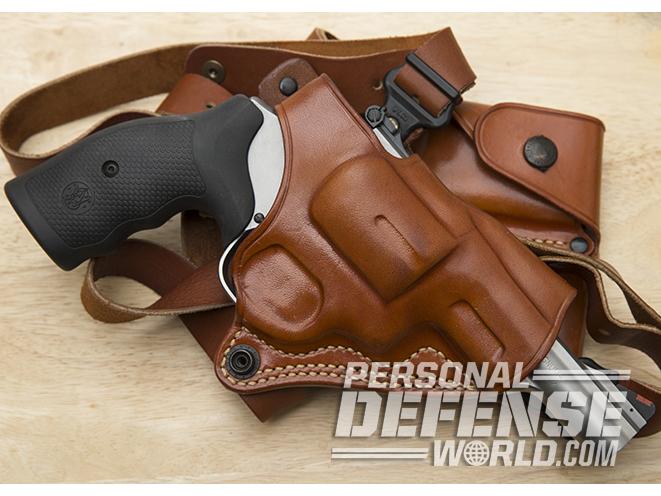
Both the Ruger GP100 and the S&W Model 69 have distinct advantages depending on the application for which they are employed. They were not chosen necessarily because they both fired .44 Special rounds, but because they were big-bore revolvers with medium frames. Smaller and lighter than their larger-framed siblings, both revolvers offer greater portability and concealability than would otherwise be allowed.
Both revolvers were accurate and robustly built to handle the larger calibers, so it all comes down to the purpose for which they are intended. For defensive carry on the streets, I would probably opt for the Ruger GP100 for its lighter weight and shorter barrel with some hot .44 Special loads for social work.
Advertisement — Continue Reading Below
If I were in need of a compact revolver capable of dishing out disaster to predators on the trail—animal or human—while keeping a low profile around pack belts or straps, the Model 69 is an excellent choice for that arena. Since the Model 69 can fire both .44 Special and Magnum rounds, it can do double duty for both tasks with the right holster selection.
Most of the differences I mentioned are subjective, so your mileage may vary. Once you try both out, you might feel differently about the distinctions. That’s why it’s great for the market that two excellent firearms companies offer products of such high caliber. It all comes down to user preference, but either way, you won’t go wrong no matter which one you choose.
Ruger GP100 Specs
CALIBER: .44 Special
BARREL: 3 inches
OA LENGTH: 8.5 inches
WEIGHT: 36 ounces (empty)
GRIP: Hogue Monogrip
SIGHTS: Fiber-optic front, adjustable rear
ACTION: DA/SA
FINISH: Satin stainless
CAPACITY: 5
MSRP: $829
S&W Model 69 Specs
CALIBER: .44 Magnum/.44 Special
BARREL: 4.25 inches
OA LENGTH: 9.6 inches
WEIGHT: 37.4 ounces (empty)
GRIP: Synthetic
SIGHTS: Red ramp front, adjustable rear
ACTION: DA/SA
FINISH: Matte stainless
CAPACITY: 5
MSRP: $849
For more information about the Ruger GP100 and S&W Model 69, visit ruger.com and smith-wesson.com.
This article was originally published in “Combat Handguns” July/August 2017. To order a copy, visit outdoorgroupstore.com.
